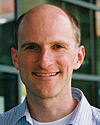NLM-Funded Investigator Creates First Complete Computerized Simulation of an Organism

Dr. Markus Covert
A team led by Markus Covert, PhD, a bioengineering professor at Stanford, used data compiled from more than 900 scientific papers to construct the first complete computer model of an organism, Mycoplasma genitalium. Dr. Covert was the recipient of a 2009 NIH Pioneer Award, jointly sponsored by the National Library of Medicine (NLM) and the NIH Common Fund. NLM is the world's largest biomedical library and a component of the National Institutes of Health.
This ground-breaking achievement in computational biology earned the cover of the July 20, 2012 issue of Cell and represents a "transforming approach to answering questions about fundamental biological processes," according to James M. Anderson, MD, PhD, director of NIH's Division of Program Coordination, Planning and Strategic Initiatives. The single-cell bacterium was chosen for its relative simplicity; it has 525 genes, compared to E. coli's 4,288. The model runs on 128 computers and:
- Describes the life cycle of a single cell from the level of individual molecules and their interactions
- Accounts for the specific function of every annotated gene product
- Accurately predicts a wide range of observable behaviors2

Cover of the 7/20/12 issue of Cell, showing a chalkboard
full of mathematical equations and diagrams used in a computer
model of Mycoplasma genitalium.
In a July 20, 2012 article in The New York Times, Covert described the object-oriented approach his team used to design the 28 separate modules that represent M. genitalium's biological processes: "The major modeling insight we had a few years ago was to break up the functionality of the cell into subgroups, which we could model individually, each with its own mathematics, and then to integrate these submodels together into a whole."
This approach uses more than 1,900 parameters observed experimentally and reported in 900+ articles, and integrates them in a manner that enables understanding and provides direction for real-world experiments. "If you use a model to guide your experiments, you're going to discover things faster. We've shown that time and time again," said Covert. NIH's Anderson is clear on the significance: "Comprehensive computer models of entire cells have the potential to advance our understanding of cellular function and, ultimately, to inform new approaches for the diagnosis and treatment of disease."
To read the full article by Dr. Covert and team:
Karr JR, Sanghvi JC, Macklin DN, Gutschow MV, Jacobs JM, Bolival B Jr, Assad-Garcia N, Glass JI, Covert MW. A whole-cell computational model predicts phenotype from genotype. Cell. 2012 Jul 20;150(2):389-401. Available from: http://www.sciencedirect.com/science/article/pii/S0092867412007763 PubMed PMID: 22817898
To learn more about the NLM Extramural Programs (grants) Division: http://www.nlm.nih.gov/ep/ep-overview.html
###
